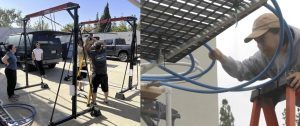Custom-built rainfall generator that creates controlled wet weather conditions to be used initially for street sweeping study

SCCWRP has developed a custom-built, field-deployable rainfall generator capable of creating repeatable, controlled wet- weather conditions to support a study investigating the effectiveness of routine street sweeping in removing contaminants that enter storm drains and contribute to runoff pollution.
Researchers envision the rainfall generator – which researchers plan to deploy in the field for the first time in August – having widespread utility beyond the street sweeping study. The instrument will enable researchers to eliminate much of the variability that surrounds interpreting water-quality data from real-world rainfall and runoff events.
The street sweeping study, which is being done in cooperation with the Southern California Stormwater Monitoring Coalition (SMC) and the City of Santa Barbara, is using a novel study design to measure how much bacteria, nutrients, trace heavy metals, microplastics and other common stormwater contaminants are transported from streets into storm drains during wet-weather flows, and if street sweeping is effective in preventing the transport of at least some of this pollution into storm drains.
The rainfall generator, affectionately known as the SCCWRPer Soaker, can generate rainfall at a controlled rate and duration across 84 square feet of surface area. The instrument spans the width of approximately one standard traffic lane and can be broken down into pieces for transport in a trailer. Researchers plan to publish the full design specifications in a peer-reviewed journal.
More news related to: Runoff Water Quality, Southern California Stormwater Monitoring Coalition, Stormwater BMPs